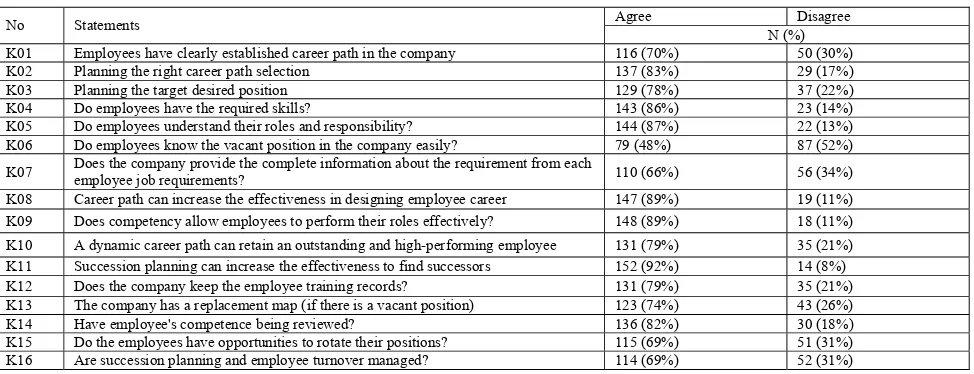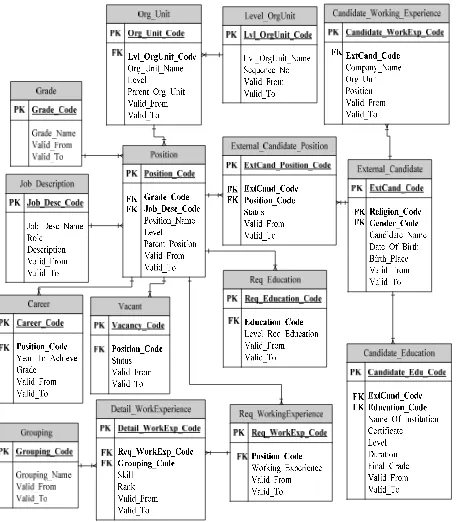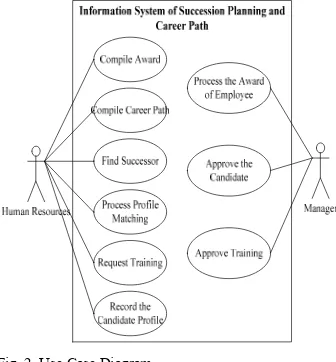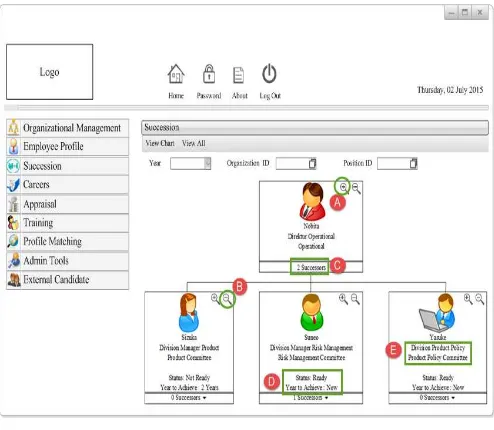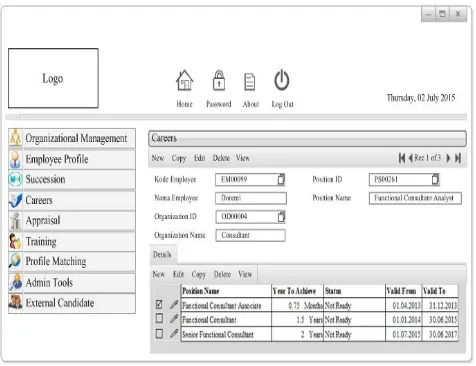Information System Model of Succession Planning
Abstract—Succession planning and career path are often used
to develop the employee career path in the organization based on their interest and capabilities. The problem is a lack of integrated information system to help the company in finding the successors of vacant positions and in mapping out the employee career path. Several methods were used in this research such as questionnaire and benchmarking with literature review. The questionnaire method consists of 16 questions which were based on Likert scale and literature benchmarking method that compared Evergreen Retirement Community, Boomers, and Brazilian Professionals to SME Sector. As for the information system design, Unified Modeling Language (UML) was utilized to produce use case diagram, sequence diagram, activity diagram, and entity relationship diagram (ERD) to help designing the user interface. The result of this research revealed an information system succession planning and career path model that is integrated and computerized to help companies in finding the successor for the vacant position and map out an employee career path.
Keywords—succession planning, career path, information system, talent management
I. INTRODUCTION
As businesses grow rapidly and more complex, human resources in a company become the primary resource and one of the priorities which need to be addressed. This condition leads to the increase of the demand for employees with skills, abilities, and knowledge. Many organizations do not have a program to create employees with high potential for the management [1]. It is a big challenge for a company to identify, develop, and maintain talents. Therefore, the company needs an integrated information system to help find successors for the vacant positions and map out an employee career path. The information system can provide data to support the evaluation of employees’ work performances, which is the sole requirement of the skill development of employees. Also, the system can support the decision-making [2].
The application of succession planning assumes that a company hired employees who fit the criteria, have basic skills, and able to increase the internal experiences for future positions [3]. Succession planning is a process to identify and to prepare employees for high potential to replace the key players in the organization [4]. There are four phases in
succession planning processes: initiation, selection, training, and transition [5]. Implementing succession planning in the company is the major evaluation system to determine employees with potential and skills.
Quality, skills, and talents are determined by the development activities and career development program provided by the organization [6]. These are to develop employees’ skills and to prepare employees for the positions or jobs in the organization. The information system is used to gather information and data to be assessed, planned and implemented [7]. If there is no available career path in the organization, it will decrease employee commitment [8]. The majority of employees will survive in the company because employees can evolve with the company. Some of the reasons that can motivate employees are opportunities for promotion and chances to be professional [9]. With an integrated system, a company is able to compare vacancies with the number of employees and obtained additional qualifications [10]. The result is a potential career path. The career path is a list of positions assigned to the employees regarding their experiences and training before occupying the position [10].
Unified Modeling Language (UML) is used to model the process of succession planning and career path into a system based on behavior, conceptual, and physical abstractions. UML has several components, which are use case diagram, activity diagram, class diagram, and implementation of relation database [11]. UML provides the resources to determine, visualize, develop, and document the system by using a diagram [12].
II. METHODOLOGY
The design method for information system was Unified Modeling Language (UML), which produced use case diagram, sequence diagram, activity diagram, entity relationship diagram (ERD), and design of user interface.
III. RESULTS
Succession planning and career path have two purposes: (1) to encourage the development of professional employees, (2) to ensure the headcount is always available. Career path allows career planning and career development for employees. Then, succession planning will find candidates for the vacant position. Information regarding employee such as qualifications, potentials, preferences, and additional careers can be used as the basis for succession planning and career path. A career path can be used to describe the employee succession planning and career path in the company. Career planning is based on the personality and the capability of an employee to determine the right position for the employee and to show the requirements of the position.
Information that have been collected from the respondents were processed by using descriptive statistics method. The data show the respondent characteristics, and the results are presented in Table 1.
Benchmarking literature is reviewed by Evergreen Retirement Community, Boomers, Brazilian Professionals, and SME Sector gave a description of the company’s needs to determine the position profile for each position and to know the prerequisite when an employee occupies a position. A company needs to identify the potential and the opportunity of an employee to get a promotion. The comparison of the abilities and skills of employees with the position profile will
produce successors for succession planning. An employee occupies the next position based on the planned career path after comparing employee's abilities and skills with the position profile. The training should be carried out if there is a gap to meet the existing gap. An employee is able to occupy the next position if there is no gap between the employee abilities, skills, and the position profile. In this research, the model of succession planning and career path was influenced by the employee competency, potential, working experiences, education, appraisals, and preferences of a position.
Succession planning process starts when there is a vacant position in the company. The successor to the vacant position can be obtained from the internal organization structure of the vacant position, career path, and the proposal from the relevant business unit. This resulted in a list of suitable candidates to hold the position. An employee has an opportunity to be transferred to an alternative position. The identified career path describes the structural promotion to the higher position or the same level of position. The user does a profile matching of an employee towards position or position towards the employee. Thus, the result from profile matching is stored in the matching result. The system automatically proposes training if there is a gap to meet the existing gap against the position profile. All employee data relating to succession planning and career path are maintained in the system. The integrated data help the user to access it. The result of succession planning and career path is stored in the system. The aim is to facilitate the management in finding the candidate for the vacant position and the career path for the employee. Thus, the relationship between the entities of the information system of succession planning and career path is shown in Figure 1a and Figure 1c.
TABLE I. QUESTIONNAIRE AND THEIR DESCRIPTIVE STATISTICS
No Statements Agree N (%) Disagree
K01 Employees have clearly established career path in the company 116 (70%) 50 (30%)
K02 Planning the right career path selection 137 (83%) 29 (17%)
K03 Planning the target desired position 129 (78%) 37 (22%)
K04 Do employees have the required skills? 143 (86%) 23 (14%)
K05 Do employees understand their roles and responsibility? 144 (87%) 22 (13%) K06 Do employees know the vacant position in the company easily? 79 (48%) 87 (52%) K07 Does the company provide the complete information about the requirement from each employee job requirements? 110 (66%) 56 (34%) K08 Career path can increase the effectiveness in designing employee career 147 (89%) 19 (11%) K09 Does competency allow employees to perform their roles effectively? 148 (89%) 18 (11%) K10 A dynamic career path can retain an outstanding and high-performing employee 131 (79%) 35 (21%) K11 Succession planning can increase the effectiveness to find successors 152 (92%) 14 (8%)
K12 Does the company keep the employee training records? 131 (79%) 35 (21%)
K13 The company has a replacement map (if there is a vacant position) 123 (74%) 43 (26%)
K14 Have employee's competence being reviewed? 136 (82%) 30 (18%)
Fig. 1a. Entity Relationship Diagram (ERD)
There are 35 entities used in the succession planning and career path information system. Several entities are not shown in this paper such as education, award, competency, and training because these entities are standard entities that company already had. Each entity contains activities and resources that are used to produce an expected result. Overall, the system is filled with implementing policy in the company for succession planning and career path process. Produced result is a candidate who replaces a vacant position and a map of employee career path.
As shown in Figure 1a and 1b, each organization which exists in the company is maintained in the system. In Org_Unit, parent is determined from each organizational unit, which gives an organization chart which is the same with the company’s organization structure. In organizational unit, there is a list of positions in each organization. Positions are determined by each parent’s position to describe reporting structure between positions. Each position has a list of successors to the vacant position. Job_Description must be maintained in the system and assigned to the position so it can be a guide in finding a successor. Successor can be obtained from the company, both internally or externally. External_Candidate data that is maintained in the system are
Candidate_Working_Experience and Candidate_Education. While for internal candidate, the data that is maintained are Emp_Education, Emp_Potential, Emp_Award, Emp_Training, Working_Experience, and Emp_Competency. These data are used to do a profile matching in the system.
Fig. 1b. Entity Relationship Diagram (ERD)
Fig. 2. Use Case Diagram
As shown in Figure 2, there are two actors that are using succession planning and career path information system. The Human resources have access to compile award and career path, find successor, process profile matching, request training and record the candidate’s profile. While the manager has access to process the employee award, approve the candidate, and approve training. Each proposed candidate by human resources must get approval from manager to decide whether the employee will fill in the vacant position or not. Furthermore, there is training needed to be followed by the employee in order to fulfill a position’s criteria.
Fig. 3. Sequence Diagram
Figure 3 shows the sequence diagram of succession planning and career path information system. The human resources need to log in the succession planning and career path to get the access. Each time the human resources log in the system, the system informs the position approved by the manager to get a replacement. The human resources start to get
a replacement for the vacant position either through internal or external candidate. Through the system, the human resources inform each chosen candidate for the vacant position replacement and training that needed to be followed after recommended training by system is requested by the human resources and approved by the manager. Activity diagram in Figure 4 discusses the detail of process of the succession planning and career path information system.
Fig. 4. Activity Diagram
Fig. 5. User Interface of Profile Matching
Profile matching as depicted in Figure 5 is used to get a comparison between succession planning and career path of a position’s profile which consists of the job description, education requirement, and working experience requirement with the employee’s profile. Working experience requirement is divided into two groups, which are hard skills and soft skills required for the position. When the user does a profile matching for succession, all of the above criteria need to be used. If the user decided to do profile matching through career path, the criteria that can be used are competency, potential, working experience, and appraisal. The profile matching gives expected employee based on the criteria. Several criteria which can be used are competency, potential, dislike, preference, education, working experience, employment at a company, and appraisal. Profile matching shows the training that the employee needed if there is a gap during profile matching process.
:
Determine profile matching type to run, such as succession and career path:
Determine profile that will be searched, such as employee, position and candidate:
Determinations based on desired profile (employee/position/candidate):
Input data that will be searched: Order matching criteria based on the most required criteria
: Do finding by clicking the find button
: Result of matching result shows the employee with expected criteria
: Training information that must be followed by an employee if there is a gap between desired position and employee’s profile
Fig. 6. User Interface of Succession
Figure 6 is the user interface succession. The successor for each position is displayed with information such as employee name, employee position and organization, and employee’s current status. When there is a vacant position in the organization, the system will display a list of employees which are ready to fulfill the vacant position. The employee readiness status can be seen through the system. If the employee is not ready, the user can click on the employee to see the gap that needs to be fulfilled, so it can be seen when the employee will be ready. The successor data can be obtained after user completes the profile matching in Figure 5. The successor can be acquired from inside or outside of a company, as well as through employee career path from different unit.
:
To see more detail about the position: Back to previous screen (after seeing details of the position)
: To know successor for the position or employee : To check whether the successor ready to replace the
superior
: Each clicked position, will be directed to below detailed position
attend a training to fulfill the gap before filling the new position.
Figure 7. User Interface of Careers
IV. CONCLUSION
Through the use of the succession planning and career path information system, company can retain outstanding and high-performing employees. A proper career path planning for the employee helps to increase retention when designing employee career. Moreover, employee can have a planning for the desired or undesirable position. Employee has the abilities and experiences based on roles and responsibilities which are already determined for the position. When there is a gap between the employee abilities and position’s roles that needs to be fulfilled or when targeting a higher position, training activity can be held to fulfill the gap. Competency evaluation and appraisal of employees are conducted to ensure the employees to carry out the roles and responsibilities effectively, and this will be an indicator for the succession planning and career path. The information system of succession planning and career path helps in increasing the effectiveness in designing employee career, planning interesting and less interesting position, monitoring employee abilities and skills, and assisting company to find a successor from internal or external for a vacant position based on its
requirements. The information system of succession planning and career path can be interfaced with third party applications such as JobsDB, JobStreet, etc. Data of external candidates can be directly incorporated into the system to create a company’s talent pool.
REFERENCES
[1] Eshiteti, S. N., Okaka, O., Maragia, D. S., Odera, O. & Akerele, E. K. (2013). Effects of Succession Planning Programs on Staff Retention. Mediterranean Journal of Social Sciences, 4(6), 157-162.
[2] Chaves, L. D., Ferreira, J. B., Camelo, S. H., Balderrama, P. & Tanaka, O. Y. (2014). Reflections on Information Systems in Health. Evaluative Search and Nursing. Enfermería Global, 13(2), 313-321.
[3] Kochanowski, Y. J. (2011). Human Capital Management in Government: Replacing Government Retirees. Journal of Health and Human Services Administration, 34(1), 85-108.
[4] Subrahmanian, D. M. & Anjani, N. (2011). Succession Planning & ITS Impact on Organizational Performance in IT Sector. Journal of Arts Science & Commerce, 2(1), 172-179.
[5] Akridge, D. J. (2011). Creating a Succession Plan, Feed & Grain, 50, 42-48.
[6] Rawashdeh, A. S. (2013). Impact of Human Resource Systems and Practices on Attitudes toward Career Development Programs in the Banking Sector of Jordan. European Scientific Journal, 9(19), 1857-7881.
[7] Amany, A., Jaclene, Z. & Christine, H. (2010). Development and Testing of Nurses Information Systems Use Instrument. Journal of Nursing Measurement, 18(2), 75-82.
[8] Nasr, L. (2012). The Relationship between the Three Component Model of Commitment, Workplace Stress and Career Path Application to Employees in Medium Size Organizations in Lebanon. Journal of Organizational Culture, Communication and Conflict, 16(1), 71-87. [9] Monis, S. H. & Sreedhara, D. T. (2011). Employee Satisfaction with
Career Development. Practices: A Comparative Study of Indian and Foreign MNC BPO Firms. Journal of Arts Science & Commerce, 2(1), 110-122.
[10] Blain, J., Dodd, B. & Nyiri, W. C. (1999). Administering SAP R/3: The HR-Human Resources Module. United State of America: ASAP World Consultancy.
[11] Ferrante, S., Bonacina, S. & Pinciroli, F. (2013). Modeling Stroke Rehabilitation Processes Using the Unified Modeling Language (UML). Elsevier Limited, 43(10), 1390-1400.
